
Small-scale embedded generation
Small scale embedded generation-connecting your generator to the grid.
Our shift towards more integrated electricity systems and new energy solutions has seen a growing number of consumers generating and distributing their own energy via the installation of small-scale embedded generation (SSEG). Our SSEG programme also responds to the large demand alternative clean energy which can be integrated back into the national grid.

Generator licensing & registration
In accordance with the National Energy Regulator of South Africa (NERSA), all generators either require licensing and registration, or are exempted from registration.

Generator network configurations
Our range of network configurations cater for off-grid systems as well as grid-tied connections, assisting you in exporting your power into the national grid.
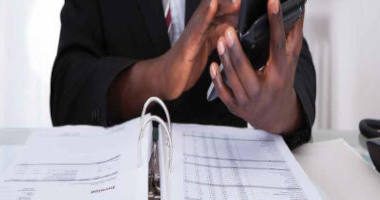
Embedded generation tariff charges
We have a selection of tariff charges that are applicable depending on your type of Small-scale embedded installation, whether you are exporting energy into the grid or not.
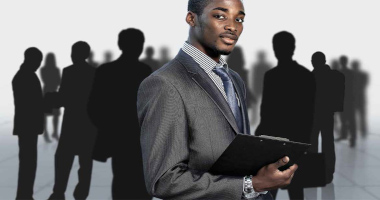
Application process
Our trained consultants are ready to assist you with your small-scale embedded generation application, making sure your generator is safely and legally connected.
An authorised SSEG ensure legal compliance and network safety. This will allow access to the following grid service benefits for al sector. View video
SSEG video


Compliance certificate report form
SSEG Pull-up banner
SSEG Generation application factsheet
SSEG wall banner
Embedded generation Peddie Mall case study
SSEG Brochure

Get in touch
If you have completed an application form for a service from Eskom, and you have sent your form to the relevant e mail address with the relevant hashtag and province in the subject line eg #Applications Western Cape, Eskom will notify you, via sms, of the milestones reached in your application.
[email protected]
[email protected]
[email protected]
[email protected]
[email protected]
[email protected]
[email protected]
[email protected]
[email protected]
Please ensure that your email has the relevant email subject heading as follows:
- For Applications related queries, please use #Application and the Province your request relates to.
- For Move In / Move Out related queries, please use #MIMO and the Province your request relates to.
- For Accounts related queries, please use #Accounts and the Province your request relates to.
- For Disconnections and Credit Extensions, please use #DCE and the Province your request relates to.
- In order for us to effectively assist you, please provide us with your account or meter number, two contact numbers and a description of your request.
- For customer complaints click here
Generator licensing and registration

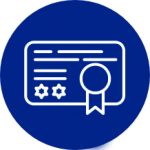
Disclaimer : The information above is based on the Schedule 2 amendment (October 2021). Please refer to NERSA for the more updated information.
Generator network configurations

A typical grid-tied generation system:
Given that this installation is grid-tied, it will require Eskom authorisation, even though it does not export energy into the distribution network. Eskom authorisation can be obtained via application, payment of fees and signing new contracts covering the tariff, legal, regulatory, metering and technical requirements.
The Eskom connection and use-of-system agreement will specify the maximum export capacity (MEC) at zero kW. For grid-tied systems, it is to be noted that the customer should install a generation system of sizing not greater than the Eskom connection installed capacity. A qualified solar installer / Engineer can provide proper further guidance and advice.
Tariff charges will not apply, but there may be costs incurred for the grid connection. Any export of energy will constitute a breach of the Eskom agreement and the supply may be disconnected by Eskom.
Depending on the criteria set out in Schedule 2 of the Electricity Regulation Act (ERA), the generator will either require registration with Eskom or NERSA.
Installations designed to consume all the generated power (non-export):
This generator network configuration provides electricity to your property when required, and is grid-tied, but designed, configured or programmed to not export energy into the Eskom power grid.
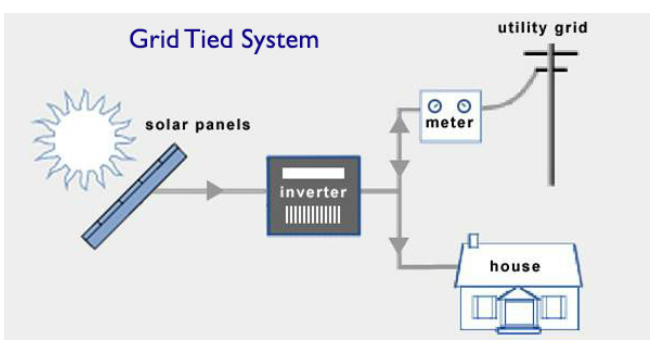
In this generator network configuration, any surplus generated energy may be exported into the grid.
This type of grid-tied generator connection requires Eskom authorisation and depending on the criteria set out in Schedule 2 of the ERA, will either require registration from Eskom or NERSA.
Eskom authorisation includes application, payment of fees and signing new contracts covering the tariff, metering, legal, regulatory, and technical requirements.
The Eskom connection and use-of-system agreement will specify a maximum energy export capacity into the grid. Tariff charges may be applicable for the exported energy, and there may be costs related to connecting the generator to the national grid.
Get to know your system – How grid-tied works:
The inverter prioritises the use of solar energy over the grid supply. Grid supply is used as supplement for when demand can’t be fully met by the grid-tied solar system. In the event of loss of the grid connection, or during a power outage, then the grid-tied system will automatically separate from the grid and the installation will have no electricity at all.
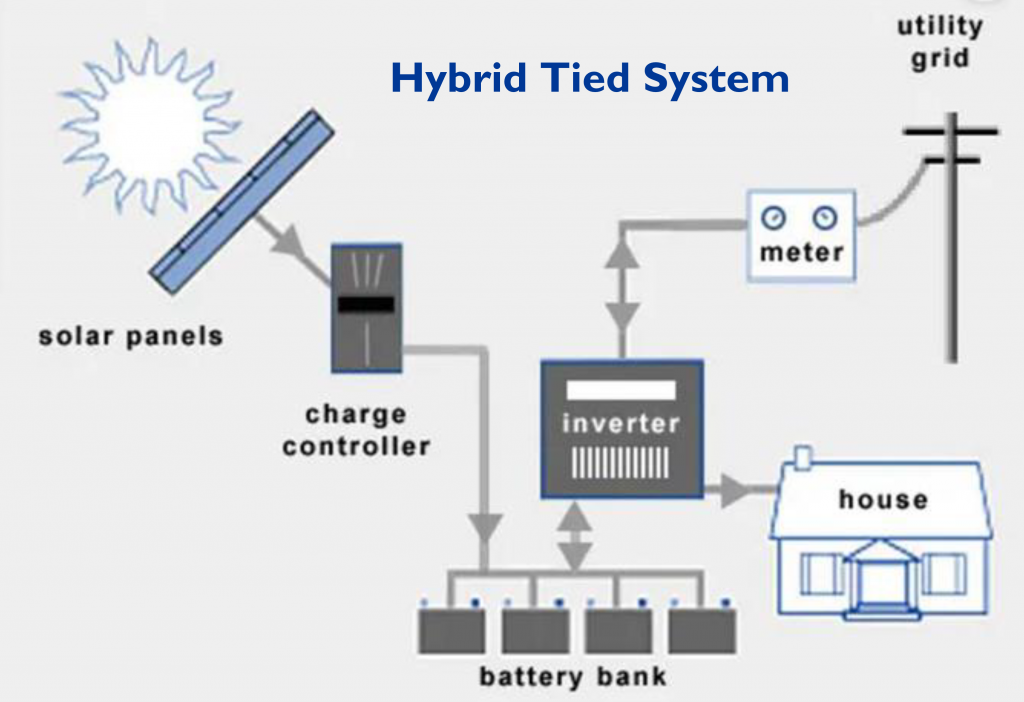
Hybrid systems:
Modern hybrid generation systems combine solar and battery storage in one and are now available in many different forms and configurations. Due to the decreasing cost of battery storage, generation systems already connected to the electricity grid can take advantage of battery storage. This means being able to store solar energy that is generated during the day and using it at night. When the stored energy is depleted, the grid is used as a backup to Hybrid System supply power and or charge the batteries when necessary, allowing customers the best of both worlds.
The allowable limits for the charging of batteries from the grid connection is dictated by the relevant Eskom technical requirements. The Eskom registration requirements for grid-tied connections shall also be applicable to Hybrid systems.
Note: In all the above cases, the Eskom registration and authorisation requirements only apply to a direct Eskom customer, and for generation systems owned and / or operated by, or for the benefit of the direct Eskom customer. The Eskom registration and authorisation do not for example apply to Metro-, municipality customers, customers of any local authority, gated community, body corporate, community scheme and the like. These customers have to follow the registration and authorisation requirements stipulated by their respective resellers.
Embedded generation tariff charges
Embedded generation application process
Small-scale embedded generation not only provides you with the opportunity to participate in the South African independent electricity generation market, but also enables you to grow your green credentials by using a renewable energy source. We have streamlined our embedded generation application process to ensure your generator is legally and safely connected to the Eskom grid. Frequently asked questions
SSEG FAQs
Eskom is currently working on the installation process, information will be shared at a later stage.
Yes, there is collaboration. Eskom is part of the German exchange programme that is currently assisting municipalities and the broader renewable industry.
No. An MV-connected generator does not have a cap, but it will depend on the technical evaluation of the network for that point of connection.
Shared network applications are currently dealt with on a case-by-case basis where a time-of-use (TOU) tariff is available.
Yes, currently it is a parallel process where Eskom quotes separately for an electrical load application as well as for the SSEG application.
It is written off. Their banking only allows you to build up “credits” until 31 March each year. Any balance of credits at that point will expire and be “lost”.
Eskom has submitted a tariff proposal for residential TOU to NERSA. We are still awaiting a response. In the meantime, when we do allow residential customers TOU connections, this will be for their use only.
Banking is a very special concession we give for small plants, where we believe we can manage the network and System Operator implications. Increasing the size may have unintended consequences from a network, revenue and cash flow perspective and management of the Distribution and Transmission system.
A quotation for both can be submitted simultaneously. You must note, however, that a fee is payable for the SSEG quotation. This fee is non-refundable. So, if you decide you do not want to proceed with the project, you will not be able to claim back this fee. If you apply for the tariff change, upgrade or conversion, this work is done on the load connection side and the quotation is usually free. Eskom would, however, advise that when you submit the application for a tariff change, an upgrade, or a conversion, you clearly state that this is in response to the future connection of a generator facility. This risk remains with the applicants if they want to submit the applications for quotations in parallel (simultaneously).
Eskom has specific rules for account consolidation, and these must first be adhered to, for example, the accounts must be for the same customer class (large power or small power).
Eskom has not yet opened the window for residential applications as we are currently preparing the resources that would manage this space. We may, on an ad hoc basis, allow an application to be processed if there is sufficient motivation to support it beyond the scope of the allowed window.
If a farm has small power points and large power points, unfortunately, Eskom will not be able to consolidate across the customer classes.
If the cost of the upgrade exceeds R1 million or the size of the upgrade exceeds 1 MVA, the quotation will not be free.
SSEG is not covered in the current standard SANS 10142-1 (wiring of premises for low-voltage installations) and therefore Eskom has established an EGI Report as an interim solution to include the compliance of an installation of SSEG while awaiting the publication of SANS 10142-1-2 (The Wiring of Premises – Part 1-2: Additional special requirement for low-voltage, small-scale embedded generator installation connected in parallel with the normal supply).
Yes, it is possible, but it will be dealt with on a case-by-case basis. There are specific rules for consolidation.
The current rules for account consolidation are that accounts must be inside the same provincial boundary, on the same feeder line, in the same customer class (large power user or small power user) and under the same TOU tariff.
The NRS097 document provides guidelines for the industry. However, safety considerations for Eskom’s staff members, equipment, and customers also have to be considered and safety also requires a visible disconnect switch in line with Eskom’s operating regulations.
This is the statutory requirement. The proposed SANS 10142-1-2 document will provide guidance to the industry as to any future requirements in this regard.
Banking is not available to connections greater than 1 MVA at present.
No, there is no application process and cost charge, but the customer still has to complete the official declaration letter to confirm that the system is off-the-grid.
This is the statutory requirement. The proposed SANS 10142-1-2 document will provide guidance to the industry as to any future requirements in this regard.
Tariffs are continuously being reviewed to take cognisance of industry trends and customer behaviour.
Eskom is proposing to make changes to the TOU charges and periods as the system profile has changed. This was included in the 2020 tariff plan, which was never decided on by NERSA. The same changes are being proposed for 2023 and this would impact the credit mechanism for net billing due to the changes to the rates and periods. Once Eskom has submitted to NERSA, detailed information will be provided to the public through forums and the Internet.
The Eskom policy concerning the hybrid application is currently being reviewed and will be communicated to the public in due course.
Application process
If all the required information and documentation are supplied timeously and required fees are paid, a
quotation can be issued between 30 and 90 days. Click here link for more information.
It depends on the scope of work. The connection time line will be indicated on the quotation.
Eskom has to make sure that all the technical, statutory and safety requirements are met.
Click here for more information
Each application will be evaluated based on its merits and will be quoted based on its individual
requirements.
Click here for more information
Yes, various options exist. Options available include: the call centre, MyEskom Customer App, SMS,
email, your customer executive, CS-Online. For detail go to Eskom’s website.
Click here for more information
Each connection has different technical requirements and therefore different cost implications.
Click here for more information
For more information consult NERSA’s website (www.NERSA.org.za)
Customers wanting to be completely off the grid should apply for termination of their supply as per the
conditions of their contract.
Yes, but this applies only to stand-alone systems.
Technical rules
This is the maximum capacity allowed for a 500kVA transformer, which is the biggest Eskom LV
transformer for new supplies. For generators greater than 350kW, the customer should own the
transformer so that they can manage the size of the transformer needed.
- The 350kW limit is applied in the application of Standard charges and in compliance to the Simple
Connection Criteria as per NRS-0970-2-3. - Any application on MV or >350kW on LV, will be quoted on actual costing.
- The 350kW limit is as per NRS 097 -2 -3. It was determined that this is the maximum safe capacity
allowed for a 500kVA transformer.
For all overhead line networks where there is a bulk supply to the customer at MV, Eskom will require
the installation of a re-closer if there is not one installed already.
No, the customer must be on a TOU tariff with an appropriate meter.
Yes, the total generation capacity supplied by all SSEGs on the feeder should be less than 15% of the
MV feeder’s peak load.
Yes, all generator installations that are grid tied to the Eskom network need permission from Eskom
before a grid tie can be made.
Any grid-tied connection without Eskom permission is deemed unauthorized and Eskom will require the
SSEG to be disconnected and a tamper fee maybe issued and lost revenue recovered. Customers are
required to apply to Eskom to be grid tied.
The following are broad-based principles:
- The generator has to be within the required size limits based on the supply point provided by Eskom.
- The metering should be able to measure the consumed energy and any energy that is exported into
the grid. - The installation will have to be tested and certified by a competent person who is registered as a
professional for these types of installations. - The equipment used should be tested against specific national guidelines as contained in the NRS
097 -2 -1 document.
The following are the actual standards that are applicable:
- Eskom 240-61268576 / DST 34-1765: Standard for the interconnection of embedded generation Part 2: Small-scale embedded generation Section 1: Utility interface.
- NRS 097-2-3 GRID INTERCONNECTION OF EMBEDDED GENERATION Part 2: Small-scale
embedded generation Section 2: Simplified utility connection criteria for low-voltage connected
generators. - South African Distribution Code.
- SANS 10142-1 & SANS 10142-1-2.
- Occupational Health and Safety Act, (Act 85 of 1993) and requirement for a COC.
- Operating Guideline for LV networks with Embedded Generation (Unique ID: 240-81732810)
and The Dead-Grid Safety lock specification minimum safety requirements for LV
connected PV Embedded Generators (Unique ID: 240-126260252) no longer a compulsory Eskom requirement.
Information on these standards can be obtained Step 2: Understand the legal and technical requirements, and more detail information can be obtained by registering on the Eskom website: https://scot.eskom.co.za
Agreements with Eskom
If your supply has been legally connected and you are on a generator tariff, then Eskom will give credits
based on the offset rate for the energy exported into the grid.
Yes. To do this the points of delivery (PODs) / premises have to be consolidated into one account. The
rules for allowing consolidation are:
- Only points of delivery (PODs) that are on the same feeder can be consolidated into one
account. - The owner of the account must be the same person or company.
- All the PODs must be on a time-of-use tariff.
For more information click here
For PODs that are not on the same feeder, a wheeling agreement can be used, but the POD has to be
connected on medium voltage (MV) or high voltage (HV) because wheeling is not allowed on low-voltage
(LV) networks. Eskom is also evaluating limiting the number of PODs linked to an account, due to the
increasing administration burden.
To be grid-tied, the generator needs to belong to an existing Eskom customer.
- Whether the generator is intending to export onto the grid, or not, Eskom will still need to ensure that
the connection is legal (registration, grid code compliance and adherence to technical standards);
that the tariff is a time-of-use (TOU) tariff option and appropriate meters are installed. - If non-adherence to the terms and conditions is evident, corrective action is taken (in the form of
remedial action i.e. Eskom will require the SSEG to be disconnected and a tamper fee maybe issued
and lost revenue recovered).
No, Eskom does not guarantee uninterrupted supply.
Yes, but wheeling is only allowed for accounts with an MV supply, – terms and conditions (T&Cs) apply.
Refer to question 2.
Yes, Authorised customers have various export options, but permission is required.
Yes, a bi-directional meter that measures energy on a time-of-use basis is required and is installed by
Eskom.
Eskom will require the customer to have the following:
- The latest Electricity Supply Agreement (ESA).
- A NERSA registration letter for supplies greater than 100kW.
- A connection and use of system agreement (also called a supplementary agreement to the ESA).
- An amendment agreement, if needed, for offset or banking of energy.
- Click here for more information
Cost considerations
Each application will be assessed on its own merit on a case by case basis.
This information will assist in the assessment of the merit of the application which is done on a case by
case basis.
There are no Eskom incentives but there are however benefits by using the grid as a battery. These are
supported with tariff options for the surplus energy exported into the grid.
Eskom is offering no financial incentives.
Each customer will need to assess his/her own return on investment.
Safety
Grid connected machines change the power flow on the Eskom network. If the operators do not know
the existence of the generators, this poses a safety risk even with a carefully controlled operations
process. The safety requirements require that Eskom gives permission for the SSEG to be grid tied.
Please consult with your supplier.
Tariffs
Eskom does not pay for the energy, however customers will receive credit on their bill for the electricity
exported onto the grid under the Gen-offset tariff. This is done per time–of-use (TOU) period and is
limited to the energy consumed in a month. There is an option for customers with SSEG up to 1MW to
roll over the excess energy onto the next month under the banking policy, subject to conditions in the
policy. Refer to the presentation on the website for more information. Click here
There are options for either wheeling of exported energy or consolidation of PODs (points of delivery),
subject to all prevailing policy, legal and regulatory requirements being adhered to. Click here for more information:
There are no additional administration charges for non-exporting customers other than the standard
connection charges to be grid tied and conversion to a TOU tariff click here for more information.
General
A generator wheeling on the Eskom network will pay applicable tariff charges (network charges,
administration charges, etc.) as stipulated in the schedule of standard charges (or Tariff book) available
on the Eskom website. Click here for more information
Not currently
It depends on the network connection.
Under the current rules:
- For MV each application will be assessed individually.
- The total generation that can be installed is based on the notified maximum demand (NMD). The total generation is always less than 75% of NMD, with an upper limit of 350kW for LV Eskom
supplies.
Note: The application to Eskom must include all grid-tied generation (total generation = solar system
inclusive of batteries).
There is no minimum size.
Yes. The types of SSEG that Eskom allow applications for are:
- Wind generation.
Photovoltaic generation (PV).Biomass generation. - Biogas generation.
- Hydro generation.
- Diesel generation.
- Battery generation.
- Fuel cells.
- Tidal and geo-thermal generation.
Yes, it will reduce pressure on the grid when volumes of SSEG increase, but in order to stop load
shedding there will have to be many combinations of generation solutions.
The control of machinery is possible. Controls such as programmable logic controller (PLC) controls can
achieve this. But you would have to contact suppliers of this type of equipment.
A generator is a machine that converts energy to electricity. The source of the energy could come from a
variety of fuels or energy sources like diesel, wind, solar irradiance from the sun, stored or moving water
systems.
There are generators that are owned, operated and maintained by property owners or tenants and which
supply some or all of their electrical power requirements. Non-Eskom owned generation refers to all
generation that is owned by these property owners or tenants, including those within municipal areas.
This is a category of customer-owned generation that is less than 1MW (1000kW) in electrical power
size and is connected to the Eskom network click here for more information
The reasons are diverse, ranging from financial benefits in terms of paying less to the supply authority, to
operational benefits such as avoiding loadshedding and loss of supply from the grid due to planned and
unplanned maintenance on the supply authority’s grid.
Municipalities have their own rules for connection and associated costs. Please consult with your
municipality if your electricity is supplied by them.
A grid-tied generator is a generator that is operating in parallel to the Eskom network i.e. it is
synchronised to the Eskom network. A grid-tied generator needs the Eskom network to be on, in order to
work. Eskom does not allow the connection of any SSEGs that can function in a hybrid mode where it
can operate both parallel and non-parallel with the Eskom grid by means of electronic controls.
A stand-alone generator works when the Eskom network is off, or supplies a section of the customer
plant not being supplied by Eskom.
An Independent Power Producer (IPP) is a generator greater than 1MW and is handled by Grid Access.
An SSEG is a supply less than 1 MW and is handled by Eskom Distribution – Customer Service.
Due to the risk of excess generation on the networks for generators above 1MW, a blanket approval for
banking is not allowed in the Banking of Energy policy. This will need to be approved on a case-by-case
basis by the Eskom Customer Service Pricing Committee. If allowed, it will only be limited to infrequent
and inadvertent over-generation i.e. not every month or more than 2 consecutive months. The customer
should demonstrate that it would generally absorb the generated energy itself or deliver to another load.
If any of the above conditions are not met, all energy exported in a billing month will be forfeited click here for more information.
Eskom charges for the use of the system related to exported energy, plus if any wheeling, offset or
banking is done, additional administration charges are charged click here for more information.
Yes, currently the offset rate is the same as the energy consumption rate in kWh. This might change in
the future, and the updated rates would be applicable upon NERSA’s approval of the new rates.
No, the credits on the offset agreement are only on the energy (kWh) per TOU and do not reduce the
other tariff rates click here for more information.
The current TOU periods are shown above – if you can manage load according to these time periods and
cut consumption during the morning and evening peaks you will save. There are various energy efficient
technologies that can be installed to reduce or stop energy consumption. The production processes
would have to be evaluated to determine energy efficient technology options click here for more information.
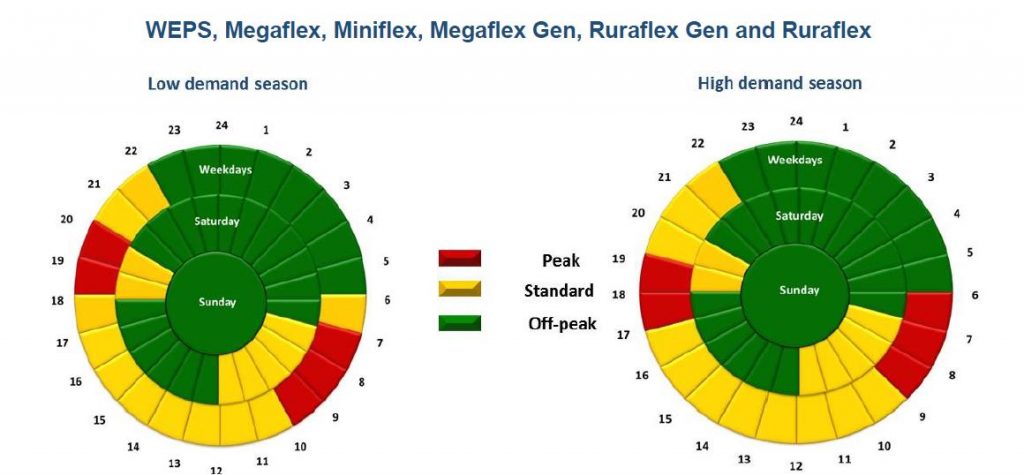
No, banking of energy is only allowed for customers on a Time-Of-Use tariff. Click here for more information
Customers will receive credit on their bill for the energy exported onto the grid under the Gen-offset tariff.
This is done per time-of-use (TOU) period. To be credited, you will be required to have a legal
connection and sign an amendment agreement to the supply agreement. Click here for more information.
Energy generated by the customer’s SSEG and which is not used by the customer, will flow out through
the meter into the Eskom grid. Specially programmed bi-directional meters can measure this excess
energy flowing out of the customer’s premises through the meter. Click here for more information.
Self-consumption – There is no energy that a customer is exporting into the grid i.e. all the energy that is generated by the SSEG is used by the customer.
Offset – The customer exports electricity into the grid and a credit is given to the customer. The customer cannot offset more than the net energy that he has used per time-of-use category (peak, standard, off-peak) for that month.
Banking – This is the surplus exported energy that is carried over to offset the next month’s consumption per TOU period. (Applicable for Eskom’s Financial year – April to March).
All the above options are considered to be grid tied and need to follow the process and adhere to the
technical requirements. Click here for more information.
Only if the customer is already on a TOU tariff.
Currently Eskom does not consolidate generator points.
